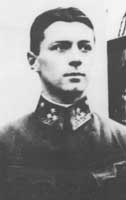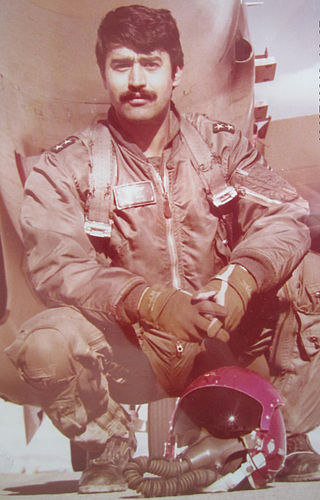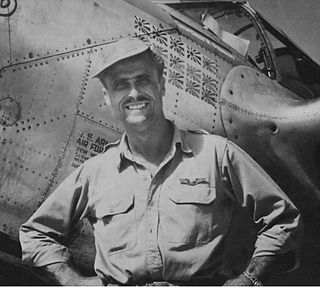Related Research Articles

A flying ace, fighter ace or air ace is a military aviator credited with shooting down five or more enemy aircraft during aerial combat. The exact number of aerial victories required to officially qualify as an ace is varied, but is usually considered to be five or more.

Capitaine Pavel Vladimirovich Argeyev, also known as Paul d'Argueev and The Eagle of Crimea, was a Russian-born flying ace of World War I, serving the French Armée de l'Air and Imperial Russian Air Service. Initially a high-ranking officer in the Imperial Russian Army, he transferred to France, where he became an aviator. He received a variety of decorations, both French and Russian, before dying in a flying accident in 1922.

Lieutenant Eduard Martynovich Pulpe was a World War I flying ace credited with five aerial victories. He was a schoolteacher engaged in post-graduate study in France when World War I broke out. As he already held a civil pilot's license, he volunteered to serve in French military aviation. His 1915 aerial victories were among the first ever recorded. After running his score to four, he managed to return home to Russia in May 1916. He was assigned to the 10th Aviatsionniy Otryad Istrebitlei. After becoming an ace on 1 July 1916, he was killed in action a month later. On 2 August 1916, Eduard Pulpe ultimately lost a nearly hour-long air battle against three enemy aircraft.

Lieutenant Mikhail Ivanovich Safonov was a World War I flying ace credited with five aerial victories. He began his naval service on 20 September 1909, when he entered Saint Peterburg's Imperial Russian Naval Academy. When he applied for aviation training in September 1915, he was a professional sailor with six years naval training and seagoing service.

Franz Peter was an Austrian flying ace credited with six aerial victories in World War I while flying for Austria-Hungary's Imperial and Royal Aviation Troops.
Captain Konstantin Konstantinovich Vakulovsky was a World War I flying ace credited with six aerial victories. A major general's son, he volunteered for aviation duty on 8 August 1914, six days after graduating from university. He taught himself to fly, and became one of Russia's first military pilots on 13 June 1915. After escaping the fall of the Novogeorgievsk Fortress in a hazardous flight, Vakylovsky flew reconnaissance missions, some through heavy ground fire. Given command of the newly formed First Fighter Detachment, he became a flying ace credited with six aerial victories. He died in a flying accident during Summer 1918.

PodpolkovnikYevgraf Nikolaevich Kruten was a World War I flying ace credited with seven aerial victories. He began World War I as an aerial observer with three years experience in military aviation. After a year's seasoning, he was recommended for, and graduated from, pilot's training in September 1914. He rose through the ranks, to be appointed as his unit's commander on 6 June 1916. With his victory tally at three, he was forwarded to service with the French Aéronautique Militaire. While learning French aerial tactics, Kruten shot down a German aircraft during February 1917. After his return to Russia in March 1917, he shared his new-found knowledge in a flurry of booklets on military aviation. He commanded his battle group of three detachments, and ran his victory total to seven before dying in a landing accident on 19 June 1917.
Captain Vladimir Ivanovich Strzhizhevsky was a World War I flying ace. He volunteered for military service on 14 October 1914, after graduation from Petrograd Technical Institute. Incomplete and confusing records credit him with eight confirmed and four unconfirmed aerial victories during his 1916-1917 combat on the Romanian Front. His second wound ended his tally of aerial victories. The advent of the October Revolution saw him co-opted into the Red Air Force for the end of the war. On 4 November 1918, he defected to the White Russian Army, and served with them for two years. When they were expelled from Russia, Strzhizhevsky accompanied them. He became a Yugoslav citizen and joined their air force.

Jalil Zandi was a fighter pilot in the Islamic Republic of Iran Air Force (IRIAF) who served during all of the Iran–Iraq War. His combat record qualifies him as one of the most successful pilots of that conflict in air-to-air combat, as well as one of the best Iranian aces ever. It also made him the highest-scoring pilot in the history of the F-14 Tomcat.

During World War I, the national air services involved developed their own methods of assessing and assigning credit for aerial victories.
PraporshikGrigoriy Suk was a flying ace for the Imperial Russian Air Service during World War I.

Robert Burdett Westbrook was a United States Army Air Forces lieutenant colonel and a World War II flying ace. Westbrook commanded the 44th Fighter Squadron, and became the leading fighter ace of the Thirteenth Air Force. He is also the ninth ranking fighter ace in the Pacific during World War II and also one of ten United States Army Air Forces pilots who became an ace in two different types of fighter aircraft.

Cyril Filcher Homer was a United States Army Air Force fighter ace who was credited with shooting down 15 aircraft during World War II.
References
- 1 2 "Baltic nations aces and pilots". Rising of the Aces. 2009. Retrieved 20 January 2016.